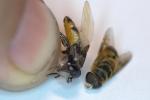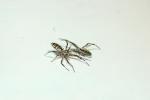-
Content Count
2,604 -
Joined
-
Last visited
Posts posted by Fred H.
-
-
-
If you are talking realistic like Fred H and Cordoba Sergio and others tie then often the process of tying them is not designed for actual fishing and the materials are not always very durable. They are more like artworks to be displayed and drooled over.If you are talking about dry flies or nymphs that mimic a real insect then I think trying to match the overall size and shape and colour of the real thing can only help you trick the fish. But then there are the fish that ignore all that and then leap on the most unlikely fly in the box. Thats the joy of fishing.
I do fish my realistic flies. I have fished my caddis pattern and midge nymph pattern sucessfully for trout. I tie realistic flies out of thread ,deer hair and monofilament . The dry flies float high ; I add lead or omit the deer hair for aquatic nymph patterns. My flies are durable and will lasts multiple fishing trips. The time I spend tying this type of fly pays out in the long run by out performing standard flys with weaker materials and nondescript features. It's ok to buy a fly from me and put it under glass but it was tied to be fished and it will perform like it should.
Please don't put me in a catagory with those that tie nymps using foam and flies too delicate that they cant be fished.
But to answer Caddichucker"s question direct. I'm not sure anyone can say for certain that one fly will work better than another , but if tied well a realistic gives you another option that the fishermen ahead of you may not have thrown. If you like I can show you a step by step of the two trout patterns I have had good sucess with. Just drop me a PM.
Fred
-
Thanks Guys , much appreciated. Murray ,I'd be honored to sign your copy.
Fred
-
Thanks Mike , it was quite a surprise .
Fred
-
Thanks Mike, I guess it's all down hill from here. lol

-
Thank you Kudu , very kind of you to say . I hope you will give it a try.
Fred
-
Thanks Ray, making the cover with my first submission is probably due more to luck or timming . I would'nt even begin to understand how someone would plan for that. I have learned alot from this site and people like yourself on presentation and photography .
Paul , I would be honored to sign a copy for you my friend. You'll notice the pattern is still evolving , let me know what you think of the leg technique.
Shoebop , thank you for your kind words,Fred
-
If you were signed in here and tried to view something in fly fishing or classic fly tying you would get that type of error message. Those are different forums with their own log in requirements.
On another note . I ignored this guy from Spain so well he doubted his own existence .
-
Thanks netabrookie,Paul and Ben. Always good to here from you guys.
Fred
-
Thank you Henrik and Mike . Henrik the wings were cut out of acetate . The veins were scribed with a needle .
Fred
-
-
Thanks guys, the head is mostly deer hair and thread with a little mono to help keep its shape.
Fred
-
Thanks Ben,Paul,PieterChristopher and Ditz. Thanks for the suggestions . This fly is in desperate need of a weed guard. I can imagine it slithering over a lilly pad and getting engulfed in a violent swirl. Hook size to head size is a concern with a fly this light. This is a #6 stinger hook and the head barely stays at the surface. Fishing open water might allow the addition of a trailor hook. I like the idea of the braid.
Fred
-
Thanks Michael, some people would say I spend too much time on my flies but I like adding the little details .
Thanks Kirk, I hope you're right.
Fred
-
-
Thanks FFL , and Paul. These spiders normaly construct their webs in an insect flight path . When they see a shadow that is too large for their web , such as a bird or animal they will attempt to make the web noticable by shaking it . Pretty cool huh.
Fred
-
Thanks Ron , with the live one to look at ,I could'nt stray too far off.
Fred
-
Thanks Mike and Piker. Having a live specimen to go by always helps. Because you never know what the fish is keying in on. Color , size ...etc.
Fred
-
-
If you re hell bent for latex remember it will dry rot over time and exposing it to direct sunlight will hasten those results. Just saying I wouldnt tie them by the dozens just to watch them go bad in yor fly box.
-
Thanks AK and Ben . Ben ,I just took a look at your blog.....looks great , keep it up.
Fred
-
More fishable than i thought! The small claws and lack of tail are great, these can cause the fly to spin if too big.Thanks, my thinking also. I patterned this off of a live crawfish I caught. Width ,length ...etc are as close as I could get them. And being tied with mono being the primary commponent it is very tough.
-
Kick ass fly! To make it fishable for me i would have to make it hook point up as i would snag it first cast and have to go and swim to get it back, maybe some weight to get it down and point up. Smallies in the rocks would chew it to pieces.Thanks . It has a mono weed guard tied underneath and a couple pieces of .025 lead for weight. With the legs and claws it still falls pretty slow.
-
Thanks Fishypieter, Peter,Flytyer56, and Piker. This pattern is still evolving . It changes a little each time I tie it but I kinda pleased with the way this one turned out.






CCG Frog Boddies
in The Fly Tying Bench
Posted · Report reply
Just for clarification the frog bodies being sold by Clear Cure Goo ( although very similar in shape and material) are not mine and I have no affiliation with that company.